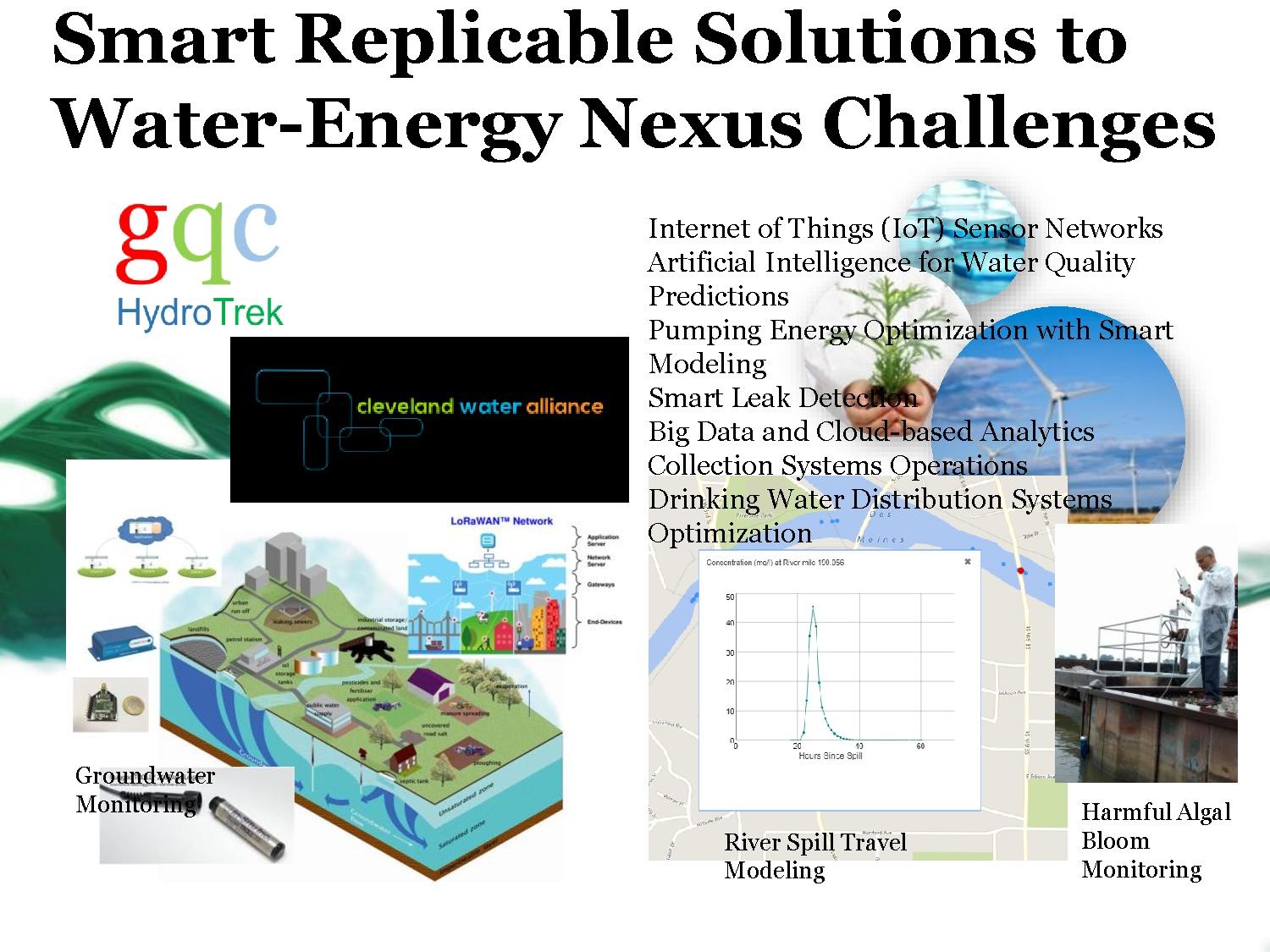Smart Water Technologies
| Smart Water Technologies | |
|---|---|

| |
 The Cleveland Water Alliance (CWA) | |
| Team Organizations | Global Quality Corp. |
| Team Leaders | Sudhir Kshirsagar |
| Participating Municipalities | Cleveland OH |
| Status | Launched |
| Document | 
|
Description
The goal of this action cluster is to provide innovative solutions for managing drinking water, wastewater, stormwater and source water resources efficiently and effectively. The smart decisions that balance energy usage with desired water quality and quantity will be supported through the development of cloud-based analytics that is driven with the “Big Data” from distributed array of environmental sensors. These “Internet of Things (IOT)” environmental sensors will be used to both monitor and control the environment. The new data will be supplemented with the data from the existing infrastructure such as SCADA historian databases and meter data. Additional data needs will be examined carefully to reduce their impact on operations. For example, water meter data is usually collected on a daily basis to prolong the battery life whereas the same data may be needed at five-minute intervals to generate an accurate demand picture. Innovative approaches that provide additional data through low-cost sensing and citizen participation will be explored.
Challenges
Integrate "Frugal Innovation."
Solutions
The smart decisions that balance energy usage with desired water quality and quantity will be supported through the development of cloud-based analytics that is driven with the “Big Data” from distributed array of environmental sensors.
Major Requirements
Innovative approaches that provide additional data through low-cost sensing and citizen participation will be explored.
Performance Targets
| Key Performance Indicators (KPIs) | Measurement Methods |
|---|---|
|
Under development |
Ongoing |
Standards, Replicability, Scalability, and Sustainability
The lack of standards for data exchange of environmental data is a major issue. There is a significant body of work mainly related to the XML-based exchange of source water data, and the US EPA is relying on Environmental Sampling, Analysis and Results Data Standard (ESAR) and Water Quality Exchange (WQX). The Standard Energy Efficiency Data (SEED) Platform is used by DOE. However, there are no standards for the “Smart City Sensor Data.” Existing data exchange formats are mainly driven by the capabilities of the underlying transmission protocols. The commercial web services have adopted “REST with JSON payload” as their standard, and the environmental web services will need to be compatible with these commercial services so that all data, whether public or commercial, can be easily consumed. This project will develop web services that support “REST with JSON” as their public end-points. It will also develop draft standards for data packet definitions for the JSON datasets. This will be a critical piece of this work because JSON format can be interpreted in a variety of ways, and different interpretations can result in incompatibilities. The REST/JSON API will be defined to promote integration with the existing standards.
Cybersecurity and Privacy
The IoT solutions leverage the LoRaWAN protocol for the node to gateway transmissions, and use technologies based on the AWS IoT client and Azure IoT client to manage the gateways from a cloud-based orchestrator. This approach allows Software Defined Networking (SDN) while providing cybersecure communications. The node locations and related metadata are stored in secure cloud-based storage to protect privacy. The LoRaWAN protocol includes advanced security mechanisms that have to be selected and implemented carefully. We created a Class A device in our implementation and used recommended OTAA (Over the Air Activation) method for authentication. We ran the LoRa Network server on the field gateway and send data forward using MQTT to the Azure IoT hub using security tokens to authenticate devices and services to avoid sending keys on the network. Additionally, security tokens were limited in time validity and scope. Our AWS-based orchestrator that manages specific field gateways uses the AWS X.509 based IoT client, and does not involve the opening of new ports into the firewall. So it substantially improves security while providing advanced device management features. In a nutshell, many millions of devices are communicating today with the architecture of LoRaWAN+ (Azure and/or AWS) but the architecture has to be carefully provisioned to provide the necessary security for the use cases. We demonstrated a cyber-secure and privacy protection architecture for our use cases using LoRaWAN, Azure and AWS.
Impacts
Not available at this time
Demonstration/Deployment
Internet of H2O hackathon